Fuji FinePix S9000By: Dave EtchellsFuji's latest bridge camera offers a larger, 9.0-megapixel SuperCCD HR imager with a high resolution electronic optical viewfinder. <<Reference: Datasheet :(Previous) | (Next): S9000 Sample Images>> S9000 Imatest ResultsReview First Posted: 12/14/2005 |
Detailed analysis of the Fujifilm FinePix S9000 images, from Imatest(tm)
I've recently begun using Norman Koren's excellent "Imatest" analysis program for quantitative, thoroughly objective analysis of digicam test images. I highly commend it to our technically-oriented readers, as it's far and away the best, most comprehensive analysis program I've found to date.
My comments below are just brief observations of what I see in the Imatest results. A full discussion of all the data Imatest produces is really beyond the scope of this review: Visit the Imatest web site for a full discussion of what the program measures, how it performs its computations, and how to interpret its output.
Here's some of the results produced by Imatest for the Fujifilm S9000:
Color Accuracy
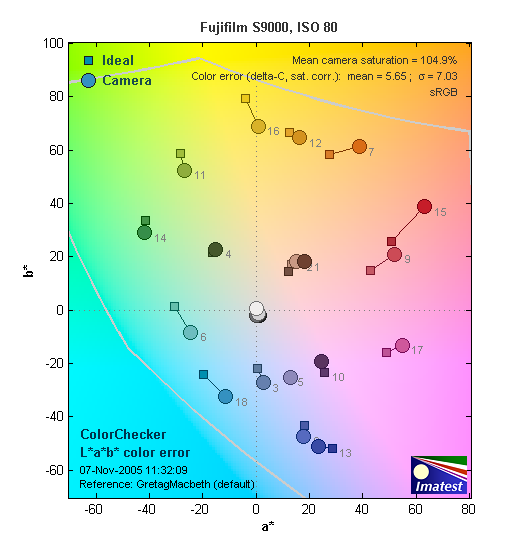
The Fuji S9000 showed fairly good hue accuracy, but with a few more hue shifts than we commonly find in the cameras we test. Likemost digital cameras, it oversaturates bright reds a fair bit, but stopped short of the point at which red hues in our test photos would have looked unnatural. The S9000 follows the common practice of shifting cyans towards pure blue (a tactic to improve sky colors), but shifts a bit more of that portion of the spectrum, extending this shift closer to the yellow-blue range than is commonly the case. Other more minor hue shifts pulled yellows very slightly toward orange and oranges a bit more toward red. Overall saturation was pretty close to the mark though, with an average saturation of 104.9% (oversaturated by 4.9%, mostly in the reds). Despite the hue shifts, average "delta-E" color error was 5.65, a good level, better than many d-SLRs achieve. (Hue error, after correction for saturation.)
Color Analysis
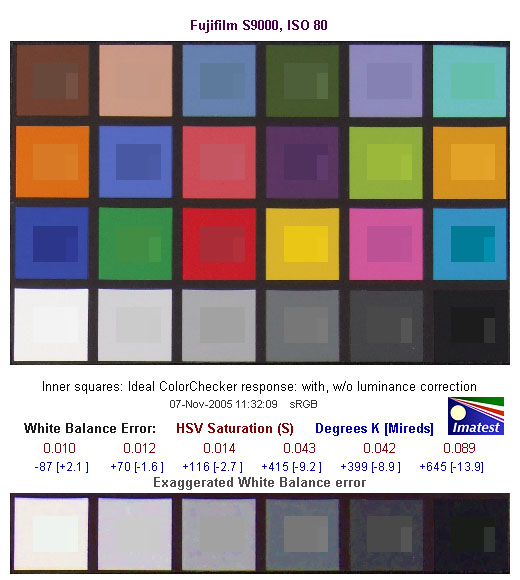
These images show the color behavior of the S9000 more directly. In each color swatch, the outer perimeter shows the color as actually captured by the camera, the inner square shows the color after correcting for the luminance of the photographed chart (as determined by a 2nd-order curve fit to the values of the gray swatches), and the small rectangle inside the inner square shows what the color should actually be, based on perfect rendering to the sRGB color space.
What we see above is something of a mixed bag, luminance-wise, with some colors being rendered more brightly than the ideal, and others darker. The net effect in photos of "real world" subjects though, is that the S9000's images managed to look vibrant and crisp, without any obvious excesses.
Gray Patch Tone and Noise Analysis
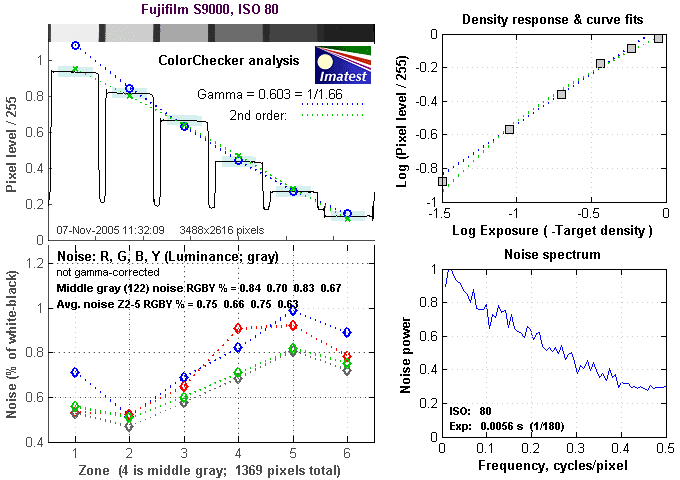
There's a lot in this particular graph, a lot more than I have room to go into here. Bottom line, the S9000's noise levels are low at low ISOs, and the noise spectrum at low ISOs is weighted toward the high frequency end of the scale more than we often find in cameras. This translates in finer-grained noise which is generally less objectionable, but since the absolute levels are so low, the fine grain structure doesn't make much difference one way or the other.
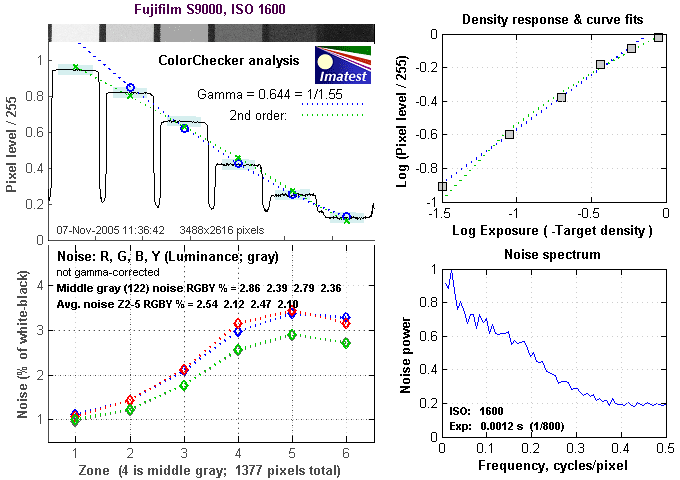
Here's the same set of noise data at ISO 1,600. The ISO 1,600 setting on the S9000 looked so rough that we wondered a bit why Fujifilm bothered to include it. The noise level increased markedly from ISO 800 to 1,700, although numerically they're not actually at all high compared to other cameras it competes with (see the chart below). The frequency content changes markedly though, as can be seen in the Noise Spectrum plot in the lower right, which at this ISO level is heavily weighted toward the lower-frequency (left) side of the plot.
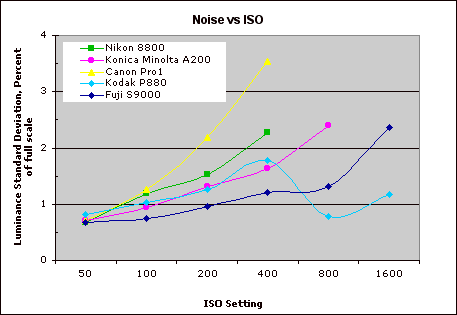
This chart compares the Fuji S9000's noise performance over a range of ISOs against that of other cameras. As you can see, the S9000's numeric noise levels arequite good when compared with the cameras it competes against in the marketplace. - Our comments about how rough its images are at ISO 1600 probably need to be placed in the context of how its competition fares. - The only other camera in the graph above that even has an ISO 1,600 setting is the Kodak EasyShare P880, which achieves ISO 1,600 only at significantly lower resolution settings, and with gross loss of fine detail. While the P880's high-ISO noise levels are quite a bit lower than those of the S9000, its image quality is significantly inferior under that shooting condition.
The chart above shows consolidated results from spatial frequency response measurements in both the horizontal and vertical axes. The "MTF 50" numbers tend to correlate best with visual perceptions of sharpness, so those are what I focus on here. The uncorrected resolution figures are 1807 line widths per picture height in the horizontal direction (corresponding to the vertically-oriented edge), and 1752 along the vertical axis (corresponding to the horizontally-oriented edge), for a combined average of 1779 LW/PH. Correcting to a "standardized" sharpening with a one-pixel radius boosted this quite a bit, producing an average of 2272 LW/PH. The uncorrected resolution rating of 1779 LW/PH is quite good for a 9-megapixel camera. The higher "corrected" are more reflective of the shape of the S9000's edge profile neatly matching what's optimum for the sharpening operator applied by Imatest than they are indicative of resolution that is truly that high. Still, there's no arguing that the S9000 delivers a lot of resolution in its images.
For the real techno-geeks, the two plots below show the actual edge response of the Fujifilm S9000, for horizontal and vertical edges. Here, we can see that the S9000's default sharpening only extends about a pixel from the edge on the light side of the tone curve, a good level, not producing excessive artifacts in the images. (This is why the S9000's images take unsharp masking on the computer as well as they do.) While not shown here, the S9000's low sharpening setting pretty completely removes all sharpening artifacts, making images shot in that mode particularly well suited for post-capture sharpening on the computer. Very nice...
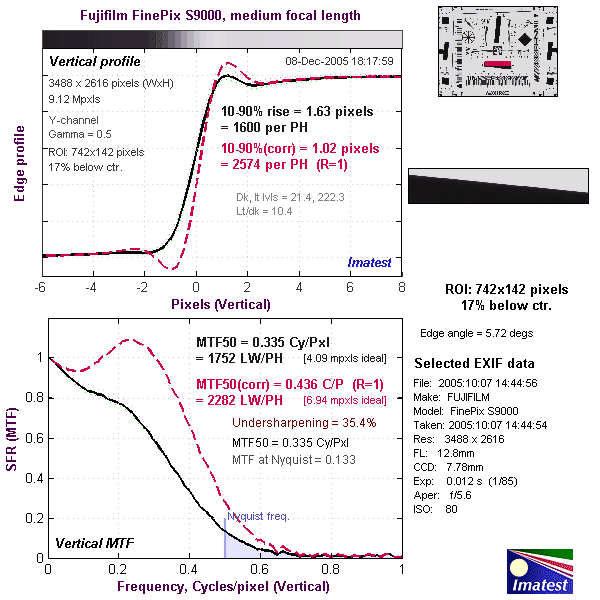
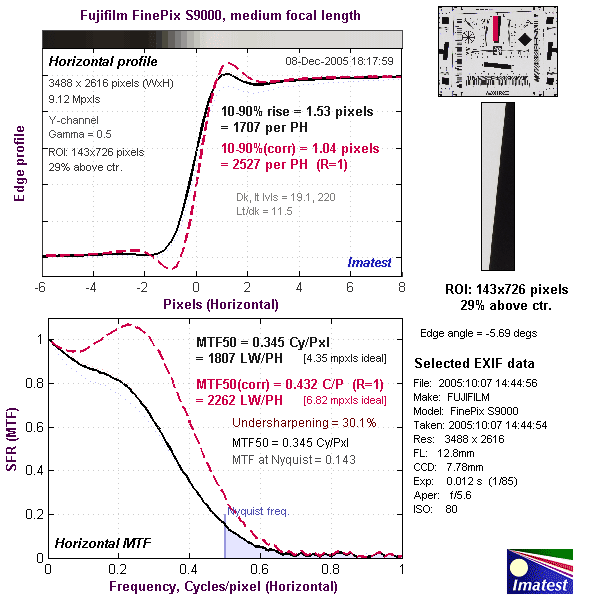
Reader Comments! --> Visit our discussion forum for the Fuji FinePix S9000!
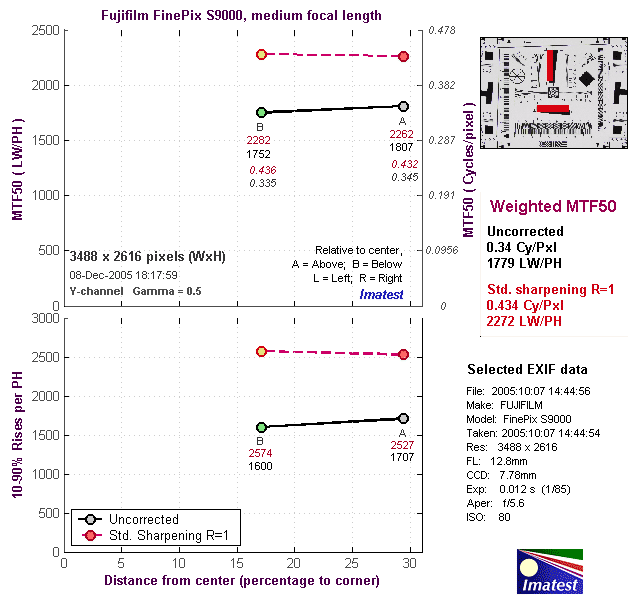

Follow Imaging Resource: